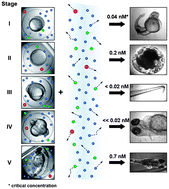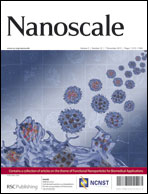Silver nanoparticles induce developmental stage-specific embryonic phenotypes in zebrafish†
Abstract
Much is anticipated from the development and deployment of nanomaterials in biological organisms, but concerns remain regarding their biocompatibility and target specificity. Here we report our study of the transport, biocompatibility and toxicity of purified and stable silver nanoparticles (Ag NPs, 13.1 ± 2.5 nm in diameter) upon the specific developmental stages of zebrafish embryos using single NP plasmonic spectroscopy. We find that single Ag NPs passively diffuse into five different developmental stages of embryos (cleavage, early-gastrula, early-segmentation, late-segmentation, and hatching stages), showing stage-independent diffusion modes and diffusion coefficients. Notably, the Ag NPs induce distinctive stage and dose-dependent phenotypes and nanotoxicity, upon their acute exposure to the Ag NPs (0–0.7 nM) for only 2 h. The late-segmentation embryos are most sensitive to the NPs with the lowest critical concentration (CNP,c ≪ 0.02 nM) and highest percentages of cardiac abnormalities, followed by early-segmentation embryos (CNP,c < 0.02 nM), suggesting that disruption of cell differentiation by the NPs causes the most toxic effects on embryonic development. The cleavage-stage embryos treated with the NPs develop into a wide variety of phenotypes (abnormal finfold, tail/spinal cord flexure, cardiac malformation/edema, yolk sac edema, and acephaly). These organ structures are not yet developed in cleavage-stage embryos, suggesting that the earliest determinative events to create these structures are ongoing, and disrupted by NPs, which leads to the downstream effects. In contrast, the hatching embryos are most resistant to the Ag NPs, and majority of embryos (94%) develop normally, and none of them develop abnormally. Interestingly, early-gastrula embryos are less sensitive to the NPs than cleavage and segmentation stage embryos, and do not develop abnormally. These important findings suggest that the Ag NPs are not simple poisons, and they can target specific pathways in development, and potentially enable target specific study and therapy for early embryonic development.


 Please wait while we load your content...
Please wait while we load your content...